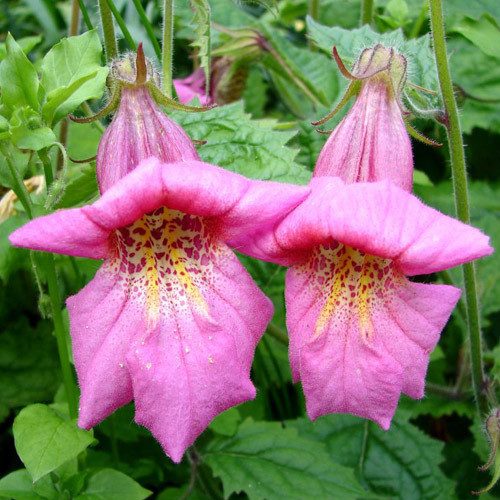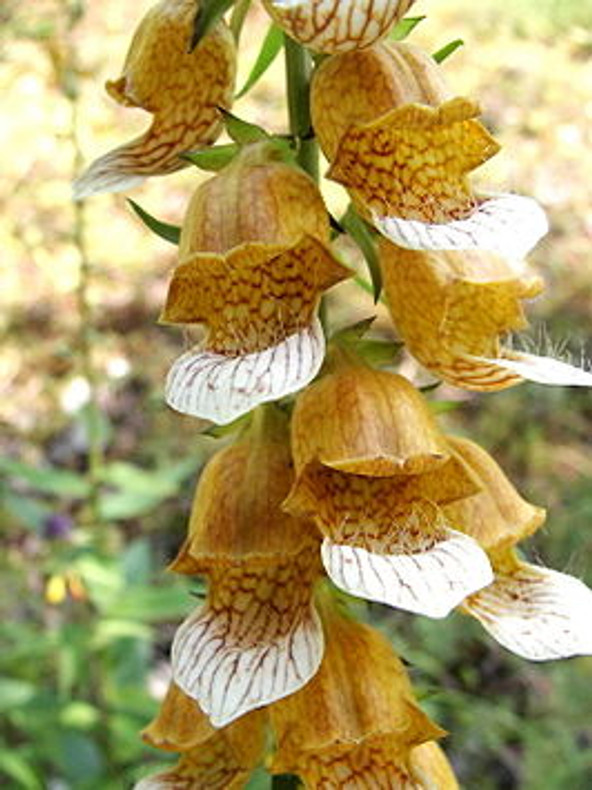The native foxglove, Digitalis purpurea, is one of the most familiar of our wild flowers and its association with man is long and complex. Digitalin, which is extracted from it, is a powerful poison and an important drug in the treatment of heart complaints.
There are many common names for Digitalis, including: Bee Catchers, Dead Men's Thimbles, Fairy Bells, Fairy Fingers or, the most common name, Foxgloves. Traditionally associated with magic, fox gloves were supposedly given to the fox by fairies so he could creep silently into the chicken run.
Although we associate it with woodland, the foxglove is essentially a hedgerow plant. It thrives best in dappled shade and is perfectly adapted to cope in sites where light varies throughout the day. It is an invaluable asset in our country where most gardens are small and separated from each other by hedges, fences or walls: perimeters are the most awkward areas of the garden but exactly the sort of venue this plant would choose for itself.
The native foxglove is usually purpley pink and spotted within. Its colour varies subtly and colonies of pure white plants can occasionally be found in the wild. Gertrude Jekyll popularised Digitalis purpurea f. albiflora, which was an essential ingredient in her white planting schemes, and it has become a popular garden plant.
We don’t sell the native Digitalis purpurea, as it’s easily grown from seed - simply scatter the seed where you want them to appear and leave the rest to nature. We do however sell a few other foxgloves:

Digitalis 'Anne Redetzky' - a dwarf foxglove, growing to not much more than a foot high. Unusual flowers of almost orchid-like appearance.
Digitalis cariensis trojana - A beautiful rare foxglove from Turkey. Strong stems of creamy white flowers delicately veined. Coffee coloured streaks within and a large white lip. The blooms last for weeks.
Digitalis ferruginea 'Gigantea' - the Rusty foxglove. This is a rather unusual species from the northern Mediterranean, featuring tall, towering wands of honey-brown flowers in the summer months.
Rehmania elata - Not strictly speaking a foxglove, but bears a striking resemblance to it, hence the common name of Chinese foxglove. The prolific blooms are long-lasting and will repeat bloom for 3 to 4 months, unlike traditional foxgloves.
Digitalis laevigata - A striking foxglove with orange and pink, large-lipped, bell-shaped flowers all summer long.
Digitalis minor 'Majorca' - The tiniest, and possibly most-attractive of all foxgloves. Very rarely offered by UK nurseries.
Digitalis purpurea albiflora - the white foxglove popularised by Gertrude Jekyll.
Digitalis purpurea 'Campanulata' - Quite curious and noted in the herbals of the 17th century. Each stem of normal foxglove flowers is terminated with a remarkable flower that resembles a campanula.
Digitalis x mertonensis - A shortish foxglove with large, soft dusky pink flowers that rise above a rosette of fairly evergreen, deep green leaves. More perennial than some.
Digitalis 'Vesuvius' - Shades of soft pink, sometimes white flowers, with lighter almost white throats. Each flower looks like it has a river of lava flowing from it.

